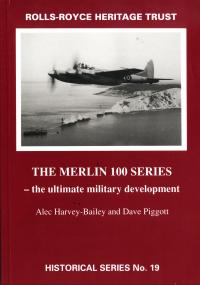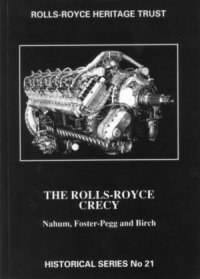Rolls-Royce Heritage Trust
Historical Series Reviews - Page 02
 |
The Rolls-Royce Dart
pioneering turboprop
by Roy Heathcote
Softbound, 210mm x 148mm x 7mm, 104 pages
ISBN: 978-1-872922-03-4
Rolls-Royce Heritage Trust
P.O. Box 31
Derby DE24 8BJ
England
Recommended Retail Price:
Please see Book List/Order Form
88 photographs/illustrations
|
Reviewed by John Martin
Performance Consultant, Rolls-Royce Corporation
Rolls-Royce Heritage Trust Historical Series No. 18
This little book is a very potted history of one of the longest serving
turbine engines around. It is a written version of a lecture first given 1987 by
the author, Roy Heathcote, who was intimately involved in the early days of the
engine's development and had a more distant involvement with it in its later
years.
In the introduction it points out that it does not attempt to be an in depth
study but outlines the history of the engine and this is indeed what it does.
One of the strengths of the lecture format is that it is profusely illustrated
with original drawings and diagrams from Rolls-Royce, together with fascinating
photographs, particularly of the early flight test era.
The book begins with a couple of background chapters which give an
interesting insight into life in Rolls-Royce in the immediate post-war era and
the way in which the early gas turbine engines were designed and developed. From
what is written, the Dart design and development team must have operated in the
manner of a Skunk Works. Clearly Lionel Howarth was a very talented and
inspirational Chief Engineer. The book shows that in this era, engines were very
much the products of individuals and small teams.
The main text and one of the Appendices lists the main team members and the
list includes many names who will be familiar to those within the aero-engine
industry and Rolls-Royce in particular, as they have gone on to greater things
in later years.
The team benefited greatly from work already done on earlier turboprops
during the development of the very ambitious Clyde and the original Trent, which
was little more than a Derwent with a gearbox. This experience was particularly
valuable in the design of the gearbox and control system.
The engine went through pretty traumatic initial running, with the
performance on the test bed being a long way from what was required and the
weight well above its target. However, the book shows that, thanks to the
application of good engineering principles the problems were identified and
solutions found, significantly improving the performance and weight. The book
gives a fascinating insight into the approaches the team took to find solutions.
However, as is still often the case, as the engine began to mature the
requirements changed and more power was needed, resulting in a redesign and
resize.
The early days of the Dart were very closely linked to the evolution of the
Vickers Viscount airliner and this is well covered in the book with the
increasing capability of new versions of the aircraft being matched by the
demand for more power from the engine.
The ultimate, wide range of applications of the Dart in both civil and
military fields is well illustrated in the book. Some of these like the Fokker
F-27 and Avro 748 were very successful commercially, whilst others like the
Aviation Traders Accountant were consigned to the history books for one reason
or another. Appendix 2 notes that the one-off applications included a B-17 fire
bomber and a version of the Mustang fighter, which can be seen at the USAF
Museum in Dayton, OH. The breadth of applications led to the engine ultimately
developing more than 3 times its original goal of 1,000 shp.
Later chapters deal with the technical features of the engine in more detail,
with individual chapters covering the gearbox, compressor and turbine sections.
Each of these is well illustrated with original drawings and diagrams, and the
text describes the evolution of many details of the design. It is here that the
written lecture format shows its weakness. The text refers to features on the
drawings but it is not clear to the reader what they are, as the terms used do
not correspond with the labels on the drawings. It is easy to imagine Roy
pointing them out to his audience at the lecture with great enthusiasm, but in
the book the impact is lost. There are also several terms used in the text which
are not familiar to the average reader, or indeed to this reader who had some
involvement with the engine in its final incarnation, resulting in the
significance of some points being lost.
Included in the Appendices is a table listing each mark of engine, its basic
details and applications and a chart summarising the evolution of the engine
capability.
Overall, this is a fascinating little book which would be of interest to
anyone wanting to understand more about the early days of aero gas turbines and
the history of one of the most enduring first generation products.
 |
The Merlin 100 Series
- the ultimate military development
by Alec Harvey-Bailey and Dave Piggott
Softbound, 208mm x 148mm x 12mm, 219 pages
ISBN: 1-872922-04-X
Rolls-Royce Heritage Trust (ML-71)
PO Box 31
Derby DE24 8BJ
England
Recommended Retail Price:
Please see Book List/Order Form
208 illustrations
|
Reviewed by Kimble D. McCutcheon
Rolls-Royce Heritage Trust Historical Series No. 19
This book forms an extension to The Merlin in Perspective
(Historical Series No. 2) and complements Rolls-Royce Piston Aero Engines
(Historical Series No. 16). Elegant illustrations comprise most of the book.
Cyril Lovesey, Chief Development Engineer of the Merlin engine during its most
important phase, saw the need to sell major changes, both to customers and to
other Rolls-Royce departments that would be responsible for implementing and
supporting the changes. He engaged Tony Dunwell to produce brochures
illustrating new features that provided cures to problems and enhanced
performance.
The 100 series Merlin combined lessons from combat
experience with performance enhancements. The result employed two-stage
supercharging, end-feed crankshaft lubrication, single-point fuel injection, and
numerous other improvements.
The superb drawings illustrate numerous technical details
of the 100 series Merlin. These include crankcase, crankshaft, connecting rods,
pistons, cylinder heads and banks, propeller reduction gearing, supercharger and
associated drive train, accessory drives and camshaft drive. Also included are
several performance charts, a catalog of development engines, a production
history, a list of Merlin Mark Numbers, and quite a few photographs of various
100 series Merlins.
This book is a must for Merlin enthusiasts and engine
modelers.
 |
The Rolls-Royce Crecy
by Andrew Nahum, R.W Foster-Pegg and David Birch
Softbound, 208mm x 148mm x 9mm, 137 pages
ISBN: 1-872922-05-8
Rolls-Royce Heritage Trust (ML-71)
PO Box 31
Derby DE24 8BJ
England
Recommended Retail Price:
Please see Book List/Order Form
59 photos/illustrations
|
Reviewed by Kimble D. McCutcheon
Rolls-Royce Heritage Trust Historical Series No. 21
In a time when we regularly zip non-stop to nearly anywhere on the planet at
speeds approaching that of sound, it is difficult to remember a world without
jet engines. Some of today's modern airline engines are approaching 100,000
pounds of thrust, and exhibit the best reliability and fuel economy of any
aircraft engines ever produced. Yet, there was a time, when gas turbines were
essentially unknown, and engine designers hoped to reliably achieve just 2,000
horsepower.
It was during this time, 1937 to be exact, that Rolls-Royce undertook the
development of one of the most remarkable aircraft engines of all time — the
Crecy. This engine was a 12-cylinder, liquid-cooled, upright 90°
-vee two-stroke. It utilized sleeve valves and was highly supercharged. It
demonstrated the capacity to produce around 2,500 shaft horsepower, and was
expected to have been capable of much more at the end of development. These
astonishing powers were achieved from only 1,536 cubic inches of displacement
and at a weight of 1,900 pounds, including contra-rotating propeller reduction
gear.
The history of the Crecy's development is chronicled in a book, The
Rolls-Royce Crecy, by A. Nahum, R. W. Foster-Pegg, and D. Birch, published by the Rolls-Royce Heritage Trust in 1994. The book is really
a collection of three chapters, each by a different author and two appendices
rich in technical detail. Softbound, it consists of 138 pages.
The first chapter, by Science Museum Aeronautical Collection Curator Andrew
Nahum, sets the stage with a short historical account of work done by Sir Harry
Ricardo. It was Ricardo who championed the cause of the single-sleeve valve,
stratified-charge, direct petrol injected two-stroke. While the Crecy was
originally conceived as a compression-ignition engine, later work by Ricardo and
the Rolls-Royce team demonstrated its potential for high power and good fuel
economy when running gasoline.
The second chapter, by Dick Foster-Pegg, provides a very detailed account of
the Crecy's development. The technical challenges, successes, and failures are
described. Foster-Pegg was an engine tester during development of the Crecy.
Finally, David Birch, R-RHT Archive editor, puts the whole program into
perspective, and provides additional details of emerging technologies that made
the Crecy possible in the first place. Also in the last chapter are tantalizing
projections of what the Crecy could have become had it not been abandoned at the
end of World War II.
The Crecy was arguably the most revolutionary aircraft piston engine ever
developed. This account of it makes good reading and is highly recommended.


